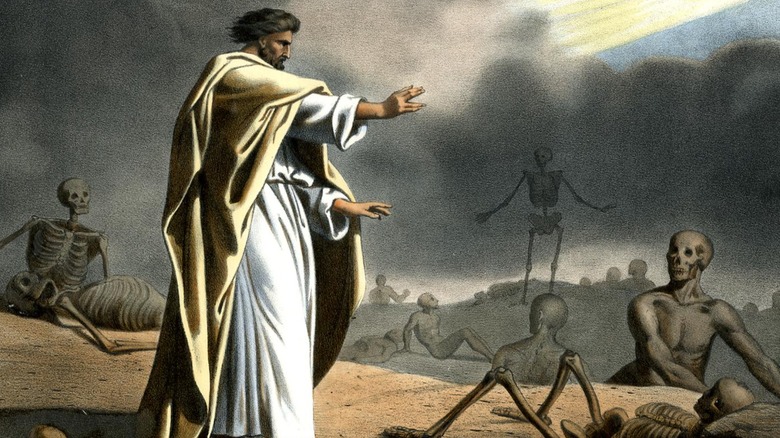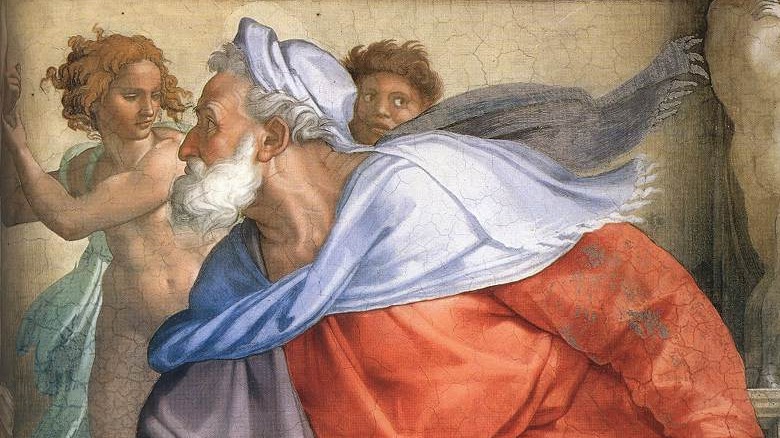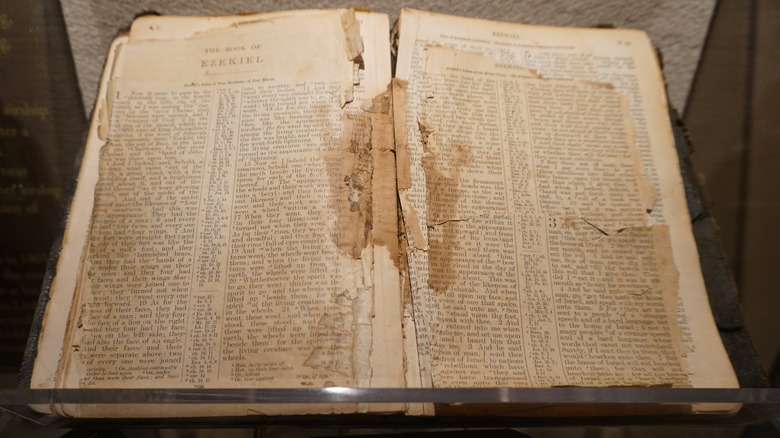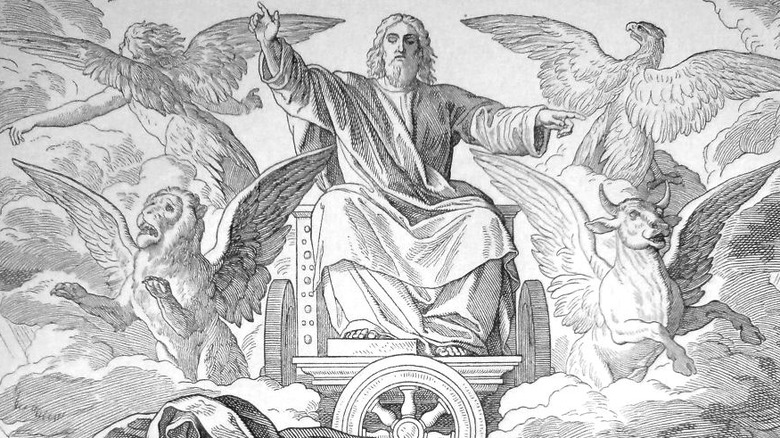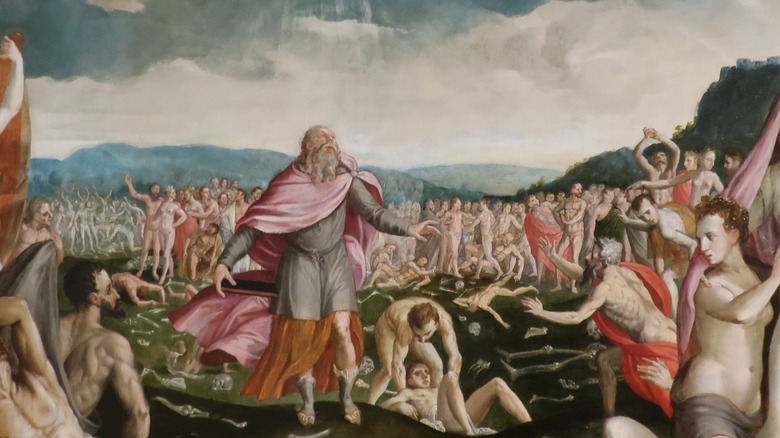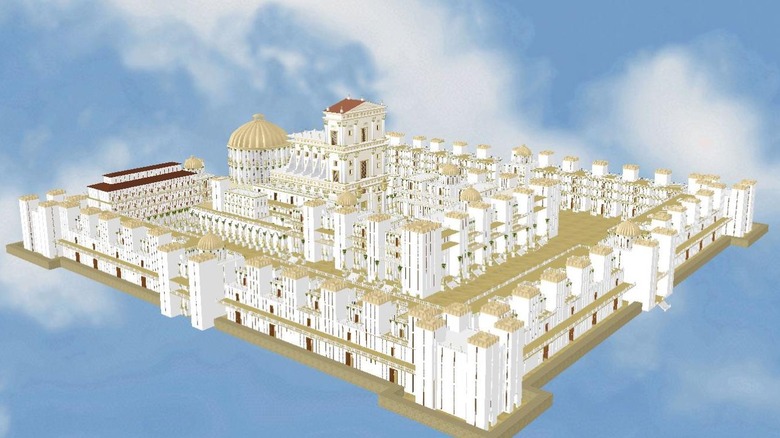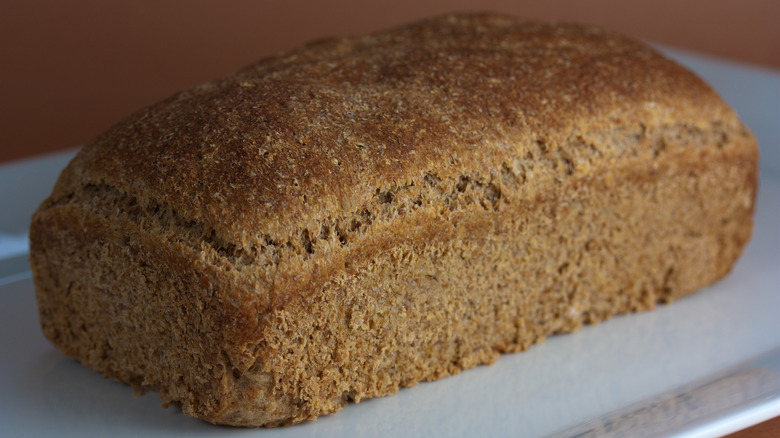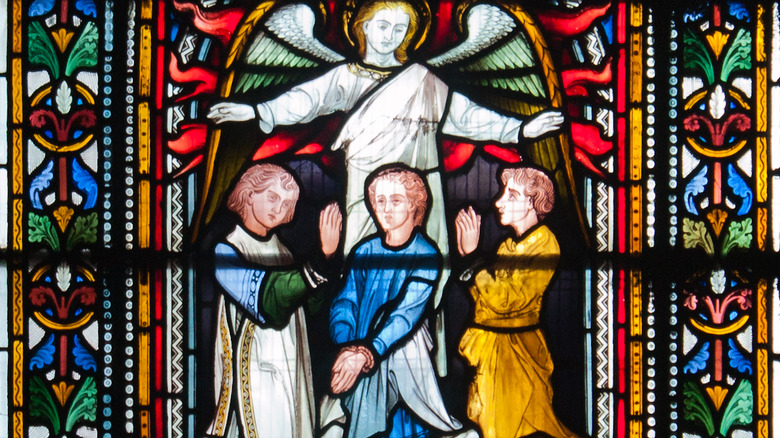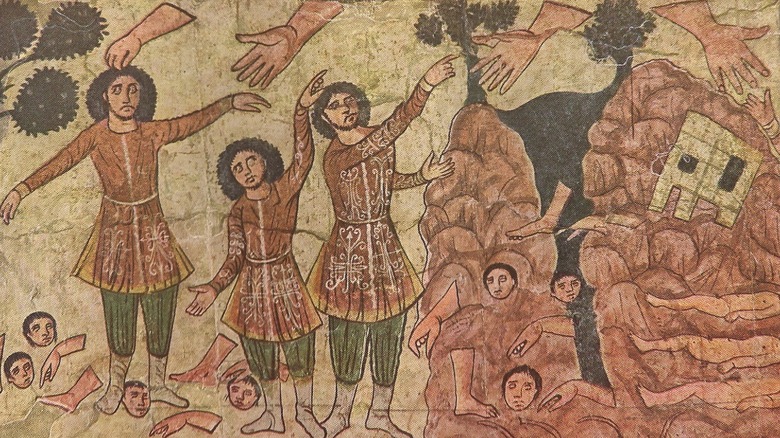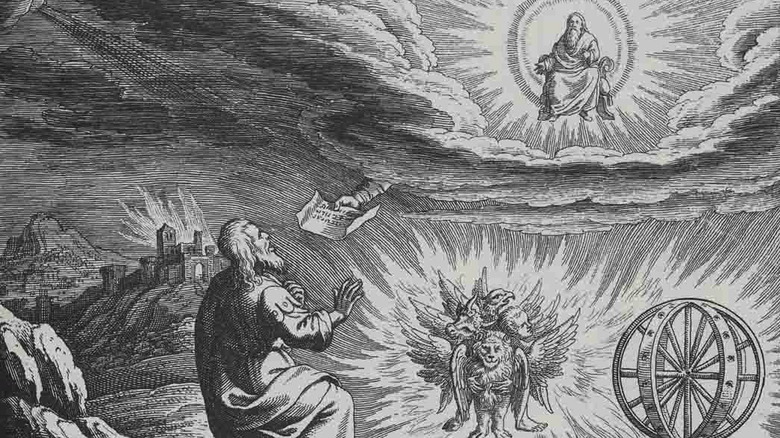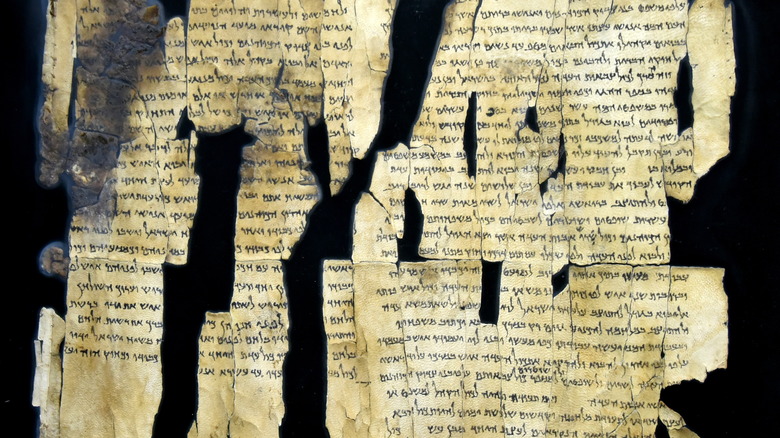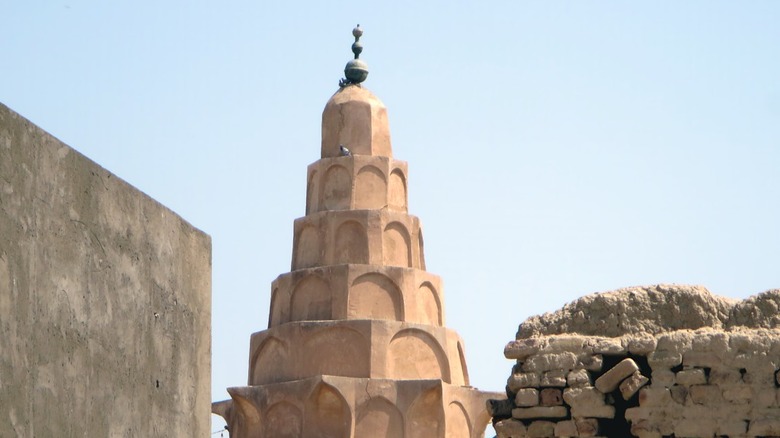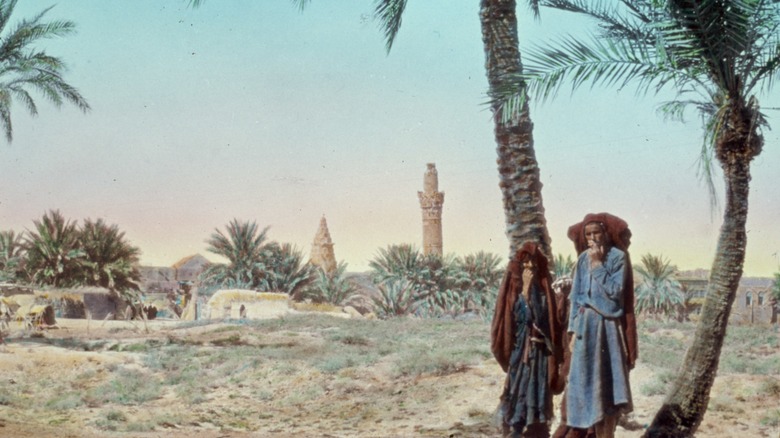The Untold Truth Of Ezekiel From The Bible
The Bible is full of a whole slew of larger-than-life figures: kings both good and bad, humble heroes raised high, and holy men whose piety allows them to do the impossible. One subsection of these standout figures is the prophets, whose job was to act as a vessel for God's message, usually warning the people of Israel to straighten up or else suffer calamity. Alternatively, when they had already suffered calamity, the prophet's job was to console the people and let them know that God will help them rebuild.
One of the three biggest prophets in the Bible is Ezekiel, who lived during the period when Jerusalem had been conquered by Babylon and much of its population taken into exile. In this time of great distress, Ezekiel offered the nation of Israel visions of God's grandeur and power over life and death. But who was Ezekiel, and what can we learn from his psychedelic visions?
Ezekiel's midlife career change
As with many biblical prophets, biographical details on the prophet Ezekiel are few and far between, as the book bearing his name is primarily concerned with his message to the Jews and their enemies, rather than whether or not he had any kids. Nevertheless, as the Jewish Encyclopedia shows, there are some details of Ezekiel's life to be gleaned from biblical sources. Ezekiel was the son of Buzi, a priest of the Zadokite line, meaning that he would have been part of the aristocracy that was taken into captivity by the Babylonians following the capture of Jerusalem in the early 6th century BCE. The Bible tells us that Ezekiel began his career as a prophet in "the thirtieth year," which is generally understood to mean his age, five years after he was taken captive by the Babylonians. According to Jewish tradition, one cannot be imbued with the spirit of prophecy outside of the Holy Land, so Ezekiel must have first prophesied in Jerusalem and retained the ability after being taken into exile together with the king Jehoiachin.
Further tradition tries to beef up Ezekiel's prophetic pedigree somewhat by claiming that Buzi, the name of Ezekiel's father, was merely a nickname for the great prophet Jeremiah ("buz" means despised, which Jeremiah would have been for his harsh pronouncements). Therefore, Ezekiel, like Jeremiah, was said to be a descendant of the Jewish leader Joshua and the converted sex worker Rahab.
Ezekiel's most notable contribution
As you might guess, Ezekiel is best known for his eponymous book of prophecy, which both Jews and Christians count among the works of the major prophets, together with Isaiah and Jeremiah. In particular, the apocalyptic visions of Ezekiel had a considerable influence on Christianity. As the Catholic Encyclopedia explains, while there aren't many word-for-word quotations of Ezekiel in the New Testament, allusions to his visions can be found throughout the Gospels and, most notably, the Book of Revelation, which references Ezekiel more than any other Christian work. For example, the discussion of the battle with the nations of Gog and Magog in Revelation 20 is an allusion to the talk of Gog from Magog in Ezekiel 38.
Despite this influence, however, Chabad explains that, according to the Talmud, Ezekiel himself was not actually the one to write down his own prophecies. Possibly because, unlike other prophets, Ezekiel did not prophesy within the Land of Israel itself, he wasn't the one to commit his vision to writing. Instead, the Talmud says that the Book of Ezekiel was compiled by the Men of the Great Assembly, a group of 120 scholars and prophets — led by the scribe Ezra – who were the religious leaders of the Jews in the time after the return from exile. Notably, the Book of Ezekiel is the rare example of a book of biblical prophecy written primarily in prose rather than poetry.
Ezekiel had a vision of biblically accurate angels
As a prophet, naturally it was Ezekiel's job to receive visions from God and announce these to the people. The Jewish Encyclopedia explains that his mission was to build a spiritual foundation for the people of Judah now that their nation and government had been destroyed. He needed to explain to the Jews, firstly, why they had suffered such a great disaster, and secondly, that it is only through the acceptance of the Lord as sovereign that will see them restored to power. To this end, the Book of Ezekiel exhibits some pretty memorable visions to display the limitless power of the God of Israel.
According to Chabad, the opening vision of the Book of Ezekiel is that of God's divine chariot, an enormous mobile throne transported by four angelic figures. These "living creatures," as they are called in chapter 1, are called cherubim in chapter 10 and are described as each having four wings and four faces: a human, a lion, an ox, and an eagle. These four creatures are later described as attending the throne of God in the Book of Revelation chapter 4, and even later become the visual symbols of the Four Evangelists, Matthew, Mark, Luke, and John. Ezekiel's awe-inspiring vision of God's rolling chair actually inspires an entire branch of Kabbalistic writings known as Merkabah ("chariot") literature, a type of mysticism that focuses on visions of the cyclopean proportions of God's domain.
Ezekiel's vision of dem bones, dem bones
While Ezekiel's first vision might have served as the main inspiration for the modern-day meme of "biblically accurate angels" as million-eyed monstrosities and wheels within wheels, the vision of God's heavenly chariot and angelic entourage might not even be the best-known vision had by the prophet. As Chabad explains, that crown might go to Ezekiel's vision of the Valley of Dry Bones, as seen in Ezekiel 37. In this vision, God leads Ezekiel to a, well, a valley full of bones, which he has the prophet command to rejoin together, to be recovered with muscle and skin, and then for their souls to re-enter their bodies to revive them. If this idea sounds familiar to you, you might have heard the popular spiritual "Dem Bones," which is based on this incident. As Financial Times explains, the song was made a hit by the Delta Rhythm Boys, but since then, the melody has become a popular children's song as well, helping kids learn that "the knee bone's connected to the thigh bone" and so on.
God tells Ezekiel that this vision is a metaphor for how the ruined nation of Israel will rise again, but for some people, it might not have been just a vision. The Talmud records that a rabbi offered as proof of the reality of the resurrected bones that he himself was descended from one of the reanimated skeletons.
Ezekiel's vision of the future temple
While the rest of the Book of Ezekiel is full of numerous prophetic proclamations – including promises of destruction for Israel's enemies, warnings of the suffering Jerusalem would experience under the siege and exile, and consolation for the surviving Jews and hopes for the reuniting of the divided kingdoms of Israel and Judah – the final major vision of Ezekiel, which runs from chapter 40 until the end of the book, nearly 20% of the whole text, is the vision of the Third Temple in Jerusalem. As Chabad explains, this vision is said to have taken place 14 years after the First Temple's destruction, decades before there even was a Second Temple. In this vision, an angel takes Ezekiel to the Temple Mount and gives him a very (very, very) detailed tour of the future temple, giving specific dimensions for its every measurement.
As Chabad goes on to explain, this visionary temple is to be enormous, over 500 acres in size, some 36 times larger than the Second Temple constructed after the Exile. It is also to be built as an enormous square, with an enormous courtyard surrounding the inner sanctums. This vision is meant to give consolation to the captive Jews, that their current sufferings are merely a temporary setback, and that the presence of God will return to Jerusalem and their future glories in the age of the Messiah will be even greater than their past ones.
Ezekiel ate poop bread
It's more than Ezekiel's visions of terrifying angels and dancing skeleton bones that might have caused the life story of the prophet to cross your path in day-to-day life. If you've ever taken a look in your grocer's freezer, you might have seen a refrigerated bread called Ezekiel bread. According to Food for Life, a popular brand of Ezekiel bread, this flourless bread made of sprouted grains is based on a recipe found in Ezekiel chapter 4. In that chapter, God instructs Ezekiel in the way that he, as a person set apart from regular society as God's spokesperson, should conduct his life differently from other people. One of those ways is that he should eat bread made from a very specific recipe: "wheat, and barley, and beans, and lentils, and millet, and fitches [i.e., spelt]." This recipe has some considerable health benefits: besides being high in fiber, this mixed-grain dough is high in both protein and flour.
It's notable, however, that the name of Food for Life's bread is Ezekiel 4:9 Bread, the verse that lists the ingredients, because they probably want to ignore God's instructions a few verses later in 4:12 — namely that Ezekiel should bake this bread into cakes over a fire made of human poop. Ezekiel, fortunately, manages to convince him that cow poop will be good enough.
Ezekiel's cameo in another Bible story
In the book that bears his name, Ezekiel enjoys a number of different notable adventures. Besides partying with skeletons and eating poop bread, he also eats a scroll and makes a little diorama of Jerusalem getting destroyed in a vain attempt to warn the people. But for some people, this is simply not enough adventures for one of God's major prophets, and so tradition ties him to a couple of other incidents going on during the Babylonian Captivity that you might have learned about in Sunday school (or from singing vegetables). According to the Jewish Encyclopedia, rabbinic tradition ties Ezekiel to the pious Hebrew children, Hananiah, Mishael, and Azariah, perhaps better known to you by their Babylonian names, Shadrach, Meshach, and Abednego. They were pals of the prophet Daniel who were thrown into a fiery furnace when they refused to worship a statue of the king.
In the version of events recorded in Louis Ginzberg's Legends of the Jews, the three youths go to Ezekiel for advice about whether they should stand firm and be executed or run for their lives. Somewhat uncharacteristically, Ezekiel tells them to beat feet. In fact, he consults with God, who tells him that he will not miraculously save them from the fire. This advice actually only steels the trio in their resolve to sacrifice themselves. God, of course, does save them from the fire; reverse psychology was his plan all along.
Reviving even more dead bones
According to the Jewish Encyclopedia, the account of Ezekiel raising the dead from a pile of dusty bones is not the only time he brought the dead back to life. Louis Ginzberg's Legends of the Jews says that the famous account of the valley of bones took place 20 years after another incident of Ezekiel raising the dead. These dead were a mix of godless Jews who had ironically denied the resurrection of the dead, members of the tribe of Ephraim who had tried to flee from Egypt without Moses, and, perhaps most significantly, a bunch of handsome young Jewish men who had been taken captive in the Exile. The story goes that they were so handsome that the women of Babylon were smitten with them, which led the Babylonian king Nebuchadnezzar to have them executed and their bodies mutilated.
The legend says that at the exact moment that Nebuchadnezzar had Shadrach, Meshach, and Abednego cast into the furnace, Ezekiel raised the mutilated youths to life, and they began to stir, shocking Nebuchadnezzar as he drank out of his cup made of the skull of a murdered Jew. One of the dead boys came up and struck the king in the face, shouting, "The companion of these three men revives the dead!" Amazed at this miracle, Nebuchadnezzar has the Jews who did bow to his idol executed, and these are the men Ezekiel raises later from the valley.
The Secret Book of Ezekiel
As with just about any biblical figure worth their salt, the prophet Ezekiel is associated with a number of apocryphal texts beyond his canonical book of prophecies. As the Encyclopaedia Judaica explains, the main apocryphal text associated with the prophet – fittingly known as the Apocryphon of Ezekiel – suffers the fate of many other extracanonical texts, namely that it survives mainly only in references and quotations from other sources. One such reference comes from the Jewish historian Josephus, who refers to two different books of Ezekiel, presumably one the canonical and the other the Apocryphon. Other ancient sources such as the early Christian church fathers Epiphanius, Clement of Rome, and Clement of Alexandria actually quote the text, giving us some fragments by which to judge Ezekiel's secret book.
The longest fragment we have is a parable in which a blind man and a man who can't walk team up to steal from the king's orchard, with the lame man riding on the blind man's shoulders and steering. The two are caught and punished. The point of the story is to prove the resurrection of the body by showing that the body and soul are inextricably linked. Another story is about a heifer (a young female cow who has never been bred) giving birth and people doubting it, which was obviously understood by some as a Virgin Mary reference.
The Pseudo-Ezekiel of the Dead Sea Scrolls
According to the Encyclopedia Britannica, the Dead Sea Scrolls are a collection of ancient Hebrew manuscripts that were discovered in caves near the Dead Sea in 1947. Their discovery was a revolution in the field of biblical archeology, as the manuscripts represent the oldest known versions of many of the texts contained inside, which include many books of the canonical Bible as well as a large number considered apocryphal as well. One of the most controversial and hardest to read of these manuscripts is one that has been named Pseudo-Ezekiel. It's possible that this fragmentary text is the same one referred to as the Apocryphon of Ezekiel, but it's impossible to know with the evidence we have now.
Prof. Devorah Dimant, an expert on Pseudo-Ezekiel, says fragments of Pseudo-Ezekiel can be found in four different copies across the Dead Sea Scrolls, which suggests the text was pretty important. The best-preserved portion of the text is a reworked version of the story of the Valley of Dry Bones, in which God resurrects the dead to answer Ezekiel's question of how God will reward the pious. This represents something of a change from the canonical version, in which the restoration of the dead is a metaphor for the restoration of the nation of Israel. This suggests that the resurrection of the dead as a reward for the righteous was a more pressing concern for the Dead Sea Scroll community.
The death and tombs of Ezekiel
The Bible doesn't tell us anything about the death of Ezekiel, though as the Jewish Encyclopedia says, tradition tells us that when God asked the prophet in the valley of bones whether the man thought God could restore the skeletons to life, Ezekiel's response was somewhat more hesitant than God was hoping for. Consequently, as punishment, Ezekiel was condemned to die in Babylon and not back home in Judah. Chabad tells that Jewish tradition reflects Ezekiel dying and being buried in Babylonia. When Nebuchadnezzar died, his son Evil-Merodach released the Jewish king Jehoiachin from imprisonment. The king took a huge entourage out to visit Ezekiel's grave, over which he later built a huge tomb that also served as a synagogue.
While the exact location of Ezekiel's tomb is unknown, there are two main sites that claim to be the home of the prophet's remains. According to Haaretz, the better known of these sites is in Iraq, the modern country where Babylon once stood. The site is now a shrine attached to a mosque in the city called Kifl, after the name of the prophet in Islam. It used to be a major pilgrimage site for Jews, but the synagogue portion of the shrine has fallen into disuse since the Jewish population fled Iraq in the mid-20th century. The other site that claims to hold Ezekiel's remains is in Turkey's Diyarbakır Province.
Miracles at Ezekiel's tomb
As you might expect with the final resting place of a significant holy man, a number of legends and traditions arose surrounding the tomb of Ezekiel. Louis Ginzberg's Legends of the Jews tells us that before Jehoiachin built his large and elaborate mausoleum for Ezekiel, the prophet was originally buried together in a conjoined tomb with the scribe Baruch, who was Ezekiel's student. A Babylonian prince commanded a rabbi to lead him to the tomb of the famous Ezekiel. Once there, however, any Babylonian who touched the gravesite was struck dead. The Jews who accompanied him were only able to enter the holy tomb after fasting and prayer, after which they managed to open it. The prince thought it wasn't fitting that the two great men should share a tomb, so he tried to move Ezekiel's body to a new location, but found that once they had carried it a certain distance, it would not move anymore, even if it was pulled by oxen. Since this was as far as it would go, here is where Ezekiel's new grave was made.
It was here that Jehoiachin visited and built his elaborate tomb/synagogue after being released from prison. This location was the site of a number of miracles, including the gates increasing in size to accommodate more visitors, barren visitors being made fertile, and floating pillars of fire.
